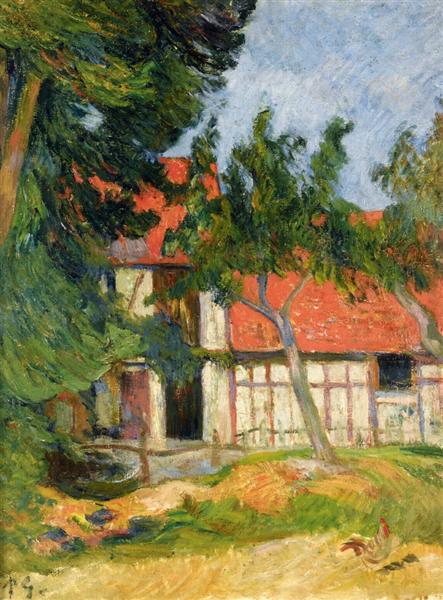Descrizione
Paul Gauguin's "Stable Near Dieppe" (1885) is a notable example of the transition from Impressionism to Symbolism, which this artist would undertake in his creative quest. Gauguin, known for his bold and vivid explorations of painting, captures in this piece a rural moment that evokes a deep connection with nature and daily life in the French countryside.
The composition of the work is characterised by a solid and clearly defined structure, with a stable dominating the foreground. Painted in a warm colour palette, this central element stands almost like a shelter, evoking an atmosphere of calm and simplicity. The earthy tones of the stable contrast with the different variations of greens in the surroundings, which include grass and bushes. This use of colour not only adds depth to the painting, but also reflects Gauguin’s interest in tonalities and the way they can modulate and intensify the mood of the work.
The sky, a mix of blues and greys, provides a dramatic backdrop that adds a sense of scale and apprehension to the painting. Through the depiction of the shifting sky, Gauguin suggests a moment of transition, perhaps between light and shadow, which enriches the visual narrative. This technique resonates with the Impressionist style of capturing specific moments in nature, but also later in his career when he would begin to employ a more symbolic interpretation of reality.
The choice not to include human figures in the painting is a fascinating aspect of this work. Gauguin focuses solely on nature and structure, implying a reflection on rural life without direct human intervention. This may raise questions about the relationship between the natural environment and human existence: we are merely observers of a world that continues independently of our presence. This stillness in representation is also an anticipation of his future work in places like Tahiti, where nature and the simplicity of daily life prevail in his art.
"Stable Near Dieppe" can be seen as a transitional work that integrates elements of impressionism while marking the path towards symbolism. The evocative atmosphere and the steps towards decontextualization, where color and form gain prominence, are aspects that prefigure his later innovations. The work stands out not only for its technique, but also for its ability to invoke a dialogue about rural life and the relationship of human beings with their environment.
Gauguin, as early as 1885, anticipated his future aesthetic concerns, highlighting a deep appreciation for light and colour, tools that he would employ in his search for a deeper and more spiritual expression in painting. "Stable Near Dieppe" is, without a doubt, a reflection of his artistic evolution and a testimony to his creative genius in the human and natural landscape.
KUADROS ©, a famous painting on your wall.
Hand-made oil painting reproductions, with the quality of professional artists and the distinctive seal of KUADROS ©.
Painting reproduction service with satisfaction guarantee. If you are not completely satisfied with the replica of your painting, we will refund 100% of your money.

